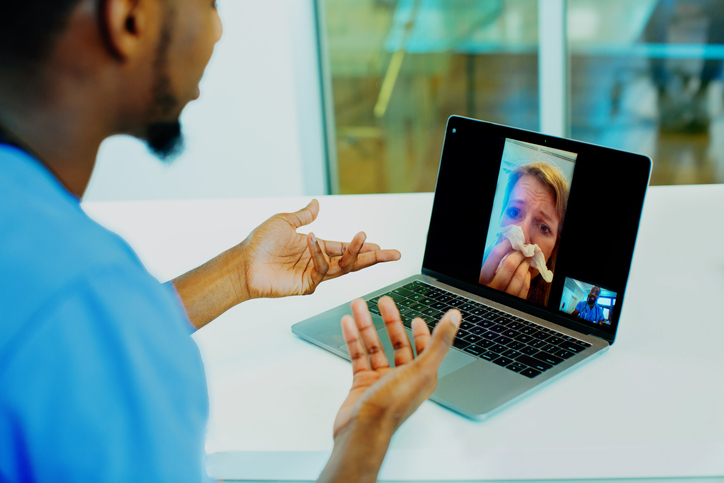What is Telehealth Nursing?
Published: January 5, 2021
Telehealth is the practice of providing clinical health care, patient and professional health-related education, public health information, and healthcare administration remotely using telecommunications technologies, including videoconferencing, image sharing, remote monitoring devices, and more.
Telehealth nursing allows nurses to carry out many of their responsibilities virtually, and can be used to streamline or automate processes, giving nurses more time for clinical work that can only be performed in-person.
There are several different forms that telehealth nursing can take, depending on the type of care the patient needs, the medical speciality involved, and the type of facility providing the care.
Common Types of Telehealth Nursing

Live video conferencing is a common form of telehealth nursing, because it allows the nurse and the patient to interact in real-time, via a video chat. Although telehealth video conferences are typically conducted on a secure, telehealth-specific platform, they are similar to video chats on familiar platforms like Skype or Zoom. Nurses can use live video conferencing to conduct basic consultations for acute or chronic care needs, explain pre-op or post-op procedures to a patient, or check in for follow-up care after a procedure.
On the opposite end of the telehealth spectrum is store-and-forward technology, which allows nurses and their patients to communicate asynchronously by exchanging messages, photos, videos, x-rays, MRIs, and more. This is a convenient way for nurses to counsel patients about non-urgent issues, without having to coordinate schedules so they are available at the same time.
Remote patient monitoring uses electronic devices and telecommunications software to monitor patients with certain conditions or needs from anywhere, without requiring the patient to travel to a particular physical location. This type of telehealth is typically used for monitoring patients with chronic conditions, and allows nurses to check in on patients for their vital signs, including blood pressure, blood sugar, heart rate, and more.
Telecommunications technology can also be used in in-person settings to streamline many routine responsibilities and enhance communication and education between nurses and patients. Hospitals and other in-patient care facilities have started utilizing interactive patient engagement systems that incorporate tablets, TVs, videos, and other technology to help educate patients and caregivers, and provide a convenient way for patients to access assistance with non-clinical needs during their stay.
Technically, telehealth nursing has existed as long as patients could call a doctor’s office or hospital and speak to a nurse over the phone. But the technological advances of the last several decades, including the advent of the internet, has made telehealth nursing much more accessible and practical.
During the COVID-19 pandemic, when it has become more important than ever for healthcare providers and patients to remain physically distant for their own health and safety, telehealth services have become a lifeline, allowing patients to get the care they need while lessening the risk of exposure to the deadly virus.
Why is Telehealth Nursing Important?
Current circumstances aside, telehealth nursing is crucial in many ways, both for patients and for nurses. While there are certain procedures and care that will always need to be performed in person, as technology advances, an increasing number of services will likely be available remotely, creating a range of benefits for patients and providers.
There are some key benefits of telehealth nursing, including:

Improves patient access to care
Telehealth nursing improves patient access to care, including people in vulnerable populations, and those who live in rural areas where the nearest healthcare providers may be several hours away.
The Association of American Medical Colleges (AAMC) reported on several ways that rural communities have benefited from telehealth services becoming more widely available. Telehealth services can not only help patients get the care they need for acute conditions, but it can improve long-term health outcomes, as patients are able to get more preventative care, and address issues before they become severe or untreatable.
Saves time and money
The time and money that patients can save by using telehealth services also helps improve access to health care. Telehealth nursing allows patients to consult with a nurse from their home, or whatever location is most convenient for them. They do not have to wait weeks to schedule an in-person appointment, take time off from work, travel long distances, pay transportation costs, arrange for childcare, or deal with any of the other obstacles that can arise when seeking healthcare. Store-and-forward services can be particularly convenient; this type of technology facilitates asynchronous communication, so nurses and patients can communicate on the schedule that works best for them.
Avoid exposure to illness
As previously mentioned, telehealth services have increased in 2020 because they can help patients and providers limit their exposure to COVID-19. However, it’s true under any circumstances that telehealth can help patients, particularly those who are immunocompromised, avoid exposure to illnesses, and protect providers from contracting illnesses that patients might bring into their facilities.
Better manage chronic conditions and aftercare
Remote patient monitoring, interactive patient engagement systems, and other telehealth tools and services can also empower patients and make it easier for them to manage chronic conditions, and aftercare following procedures.
Many patients end up back in the hospital after illnesses and procedures because they do not take the proper steps to care for themselves when they are released. Hospital readmissions are costly in a number of ways for patients, hospitals, and their staff. Hospitals spend about $26 billion annually on readmissions alone. Readmissions also mean that there are more patients in the hospital, which impacts workloads for nurses and other staff. For patients, readmission to the hospital can be frustrating, financially straining, and potentially life-threatening.
Before patients are discharged, interactive patient engagement systems can help educate patients and their caregivers about the proper procedures for aftercare. Responsive technology can adapt to a patient’s language, culture, age, reading level, and other factors, and provide real-time feedback so patients and nurses can feel confident that everyone understands what needs to be done, and how to do it.
Once patients are released, remote patient monitoring and video conferences can make checkups far more convenient. Through wearable and biosensor devices, nurses can monitor patient’s vitals to ensure their recovery is progressing according to plan. If patients have questions, they can contact a nurse or healthcare provider through a video chat, without needing to return to the hospital in person.
Balance nurse workloads
Telehealth nursing has benefits for nurses as well. Currently, nurses must juggle many clinical, administrative, and caregiving tasks. Furthermore, the U.S. is expected to experience a shortage of registered nurses (RNs) in the next decade, as a significant number of RNs reach retirement age, the over-65 population increases, and healthcare regulations change. It’s essential that nurses are empowered to use their time, energy, and resources wisely, so they can ensure their patients receive the highest level of care while avoiding stress and burnout.
Telehealth nursing provides nurses with tools to balance their workloads, and focus their energy on providing hands-on care. For example, using an interactive patient engagement system to teach patients and their caregivers about the proper procedures for aftercare can free up time for the nurse to focus on other clinical or administrative tasks. These systems also often have tools that can help patients address non-clinical concerns, like room temperature or ordering meals, so nurses do not have to take time from their busy schedules to attend to these needs. This means nurses have more time and energy to focus on their clinical responsibilities, resulting in a higher level of patient and staff satisfaction.
Conducting consultations and monitoring patients remotely can also add more flexibility to nurses’ schedules. Nurses do not need to be in a specific location to have a video consultation with a patient, and remote patient monitoring allows for more efficient checkups.
Types of Technology Used for Telehealth Nursing
There are several different types of software and hardware needed for telehealth nursing, particularly for providers, although in some cases, patients must also have the proper software and equipment.
For example, for patients and nurses to conduct video consultations, both parties must have a device with a camera, reliable internet access, and some type of video conferencing software. There are many proprietary platforms designed specifically for telehealth, which integrate strict security protocols, as well as other tools for scheduling, e-prescribing, electronic health records, and more.
Remote patient monitoring also requires special equipment, like biosensors, wearables, handheld consoles, vital signs monitors, or other devices. These devices connect to the internet, so they can transmit information directly to a nurse or physician.
Within hospitals or other facilities, nurses may use telemedicine carts, which are portable workstations that include all of the necessary equipment for recording or transmitting patients’ health information, including computers, cameras, monitors, and mobile medical devices.
Facilities using interactive patient engagement systems will also need software programs that can provide patients with educational resources, such as videos, and generate activity reports for staff to review, facilitating follow-ups from clinicians when needed. These facilities must also have the right equipment, such as TVs, controllers, and tablets, that are integrated with the software and easy for patients and staff to use.
Sources
- https://www.aamc.org/news-insights/telehealth-helps-close-health-care-disparity-gap-rural-areas
- https://www.healthstream.com/resources/blog/blog/2020/06/02/the-economic-emotional-cost-of-hospital-readmissions#:~:text=The%20cost%20of%20hospital%20readmissions,the%20program%20received%20readmissions%20penalties.